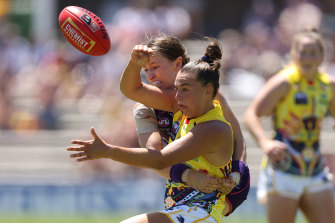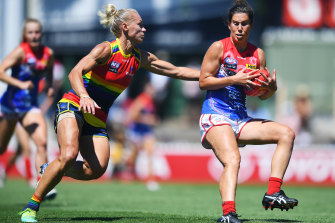A milestone moment in AFLW’s evolution
It’s hard to believe I will run out for my 50th game on Saturday night, a milestone celebrated by Adelaide star Ebony Marinoff and Brisbane Lions pair Ally Anderson and Emily Bates last weekend.
It feels like yesterday that I played my very first AFLW game. It was February 4, 2017 – just the second game of AFLW, the day after the famous lockout at Ikon Park began the inaugural competition with a bang.
Adelaide star Ebony Marinoff.Credit:Getty Images
Since that first night, I have been privileged to play for two clubs without missing a game over the past five seasons, including playing in four finals and one premiership, with the Western Bulldogs.
What stands out for me over my 50 games is how much the game has evolved. The past fortnight is testament to that. There have been two record-breaking scores: the Brisbane Lions scoring 98 points in round eight and then Melbourne piling on 107 points in round nine.
Here’s how the game has improved: in the inaugural year, I was recruited as a cross-code “rookie”, having played elite-level netball. Five years later we see far fewer athletes coming across from other sports. This is because we now have an established pathway from Auskick to the big time. The AFLW competition is now reaping the benefits of “footballers” who have been playing the game all their lives.
Girls no longer have to stop playing at 12 or13 because they aren’t allowed to play with the boys. This elite pathway has set our female footballers and this competition up for success.
Each year the competition has demanded each athlete get stronger, fitter, faster and more skilful. The AFLW is home to some of the most competitive athletes in the country. You know if you’re not training, your opponents are. Personally, every season I have had to go to a new level physically; we all have. The extra investment in off-season training has also gone to a whole new level.
This off-season I worked one-on-one with a weights and footwork coach twice a week to ensure I could match it with the best for my team this season. More players are catching up for running and extra skill sessions together, so they are not left behind.
A great example of how individuals have grown with the game itself is Marinoff. A dual-premiership player with the Crows and three-time All-Australian, Eb has become one of the best all-round midfielders in the competition. Originally more of a defensive midfielder, averaging 15 disposals, 9.5 tackles and two score involvements in 2017, Eb has added not only more disposals to her game with an average of 25 this year but can contribute to her team’s scoring ability with four clearances, five inside 50s and four score involvements per game.
The game style of each team, particularly the inaugural eight, is now easily recognisable. The strategy to get the four points every week is more complex and insightful. For example, Adelaide are very much a surge-forward-and-gain-territory team, North Melbourne a measured, uncontested side with players who can hit a target from anywhere. We now see an extra player in defence in an attempt to swing the game back their way; and wings taking a key role in team structure, plus tagging and role-playing players.
As a defender, there is no way I can now sit off my opponent and wait for a kick down the line. The methods and smarts behind each player and team mean each kick deserves a huge amount of respect.
The game statistics from 2017 to 2022 reveal some healthy improvements. Average disposal efficiency has gone up by 10 per cent per game. While this might seem “lowish” from an outsider’s perspective, when we compare where we played in 2017, being 72.4 per cent at unprotected grounds compared with this year with 94 per cent of games being played at unprotected grounds, the difference is huge. An unprotected ground is a local community oval with no protection from elements. We now have the skill to play in tougher conditions.
Most importantly, what the last two weeks have shown us is that if we get the opportunity to play at protected grounds (stadiums), record-breaking scores can be kicked.
Uncontested possession is a stat that describes a team’s ability to hit targets consistently, have control over a game and the ability of the players to implement game strategy more efficiently. This has increased substantially since 2017, with each of the eight inaugural teams increasing total uncontested possessions by 30-40 per game.
Melbourne’s Libby Birch in action against Adelaide’s Erin Phillips. Birch will play her 50th game this weekend.Credit:Getty Images
Adelaide are one of the most improved in this area. In 2017 they averaged 76.3 uncontested possessions a game; this year they average 128.1.
Running through the banner on Saturday with my red-and-blue family will be a proud moment. Before the bounce I will reflect on what I have witnessed over my 50 games; not just what I have seen on the field, but off it as well: a competition that has grown from eight teams to 14, from 240 AFLW players to 420, from 318,000 girls and women playing the game to more than 600,000.
Yes, we have come a long way in 50 games, and I’m excited to see where we can go over the next 50.
Keep up to date with the best AFL coverage in the country. Sign up for the Real Footy newsletter.
Most Viewed in Sport
From our partners
Source: Read Full Article


